Wednesday, April 19 2017
At almost any time, lots of MIPS members ask questions like:
1) Is MIPS getting ready to issue a new signal?
2) What makes MIPS issue a new signal?
3) How much does the market have to drop before a MIPS model issues a "Short Signal" ?
etc, etc, etc.
To understand the answer, one has to understand the concepts of some of the underlying algorithms in the MIPS models. Most "timing models" on the market today are what we would call "Linear Models", which means they basically do the same thing every time a "similar" event happens (like the SPY crossing its 200-day EMA), without regard to different external circumstances.
The MIPS models are much more "self-learning and self-predicting", which means that the MIPS models not only want to know where an indicator stands (like the SPY being above or below its 200-day EMA), but how it got there and where might it go from where it is now. A simple example of this is, if the SPY is 1% below its 200-day EMA, most models would rate this as "negative". But, the way that MIPS would look at this is, if the SPY is 1% below its 200-day EMA and it got there by falling from 6-8% above the 200-day EMA in the last 30 days or so, MIPS would look at this as negative. On the other hand, if the SPY is 1% below its 200-day EMA, BUT it got there by climbing up from 6-8% below the 200-day EMA in the last 30 days, MIPS would look at this as positive (because the "slope" or direction of the SPY is pointing up strongly).
Another, a more pertinent example of MIPS being "adaptive" and not simply doing the same thing every time a "similar" event happens, is that sometimes it takes a 5-6% move in the SPY for MIPS to trigger a new signal (like from Long to Short); but at other times, MIPS could "trigger" a new signal with a move of just 2-3%. This decision is made inside the MIPS models, and it depends upon the "relativity" of the most recent, short-term "move" in the SPY compared to the longer-term behavior of the market.
Examples
Graph #1
The MIPS models would most likely NOT go short on 4-6% drops in the SPY if the market has moved up 12-25% on a strong trend of intermediate-term cycles in the previous several months (kind of like now).
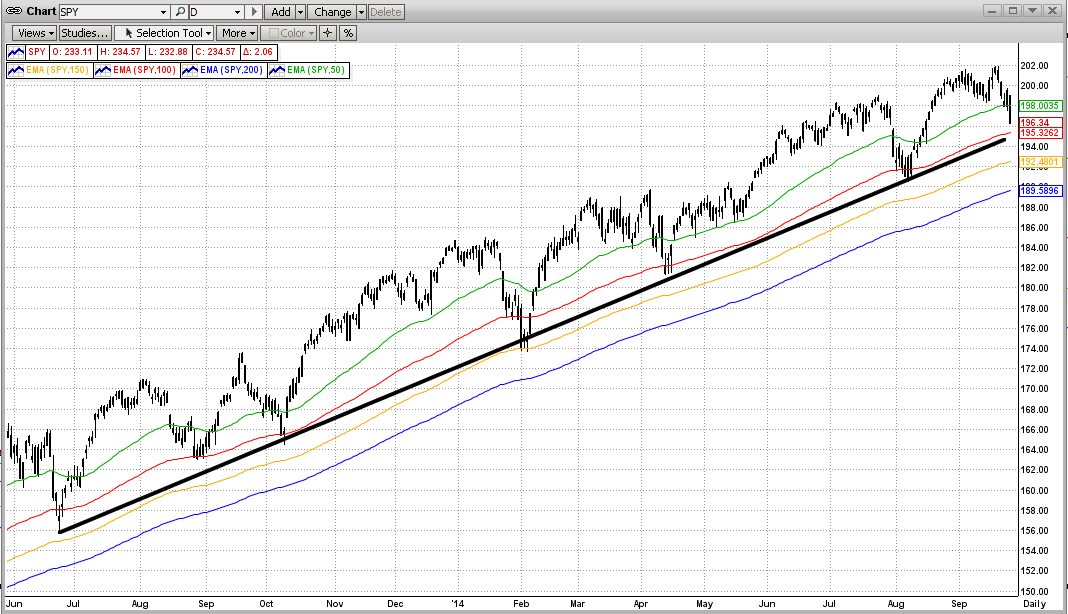
Graph #2
The MIPS models could go short on just a 2-3% drop in the SPY if the market trading range in the previous 3-4 months has been relatively flat; because a 2-3% drop is "significant" relative to the up/down volatility in a flat market. This is a very positive trait of the MIPS models because long-term market trends do not simply change direction instantly, but rather they "waffle" at the top or bottom for a several months (up to 12-15 months) before completely changing direction (called "Topping"). Note - the red and green vertical lines in the graph below show "actual" short and long signals from the MIPS3 model near the beginning of the 2008 Market Crash.
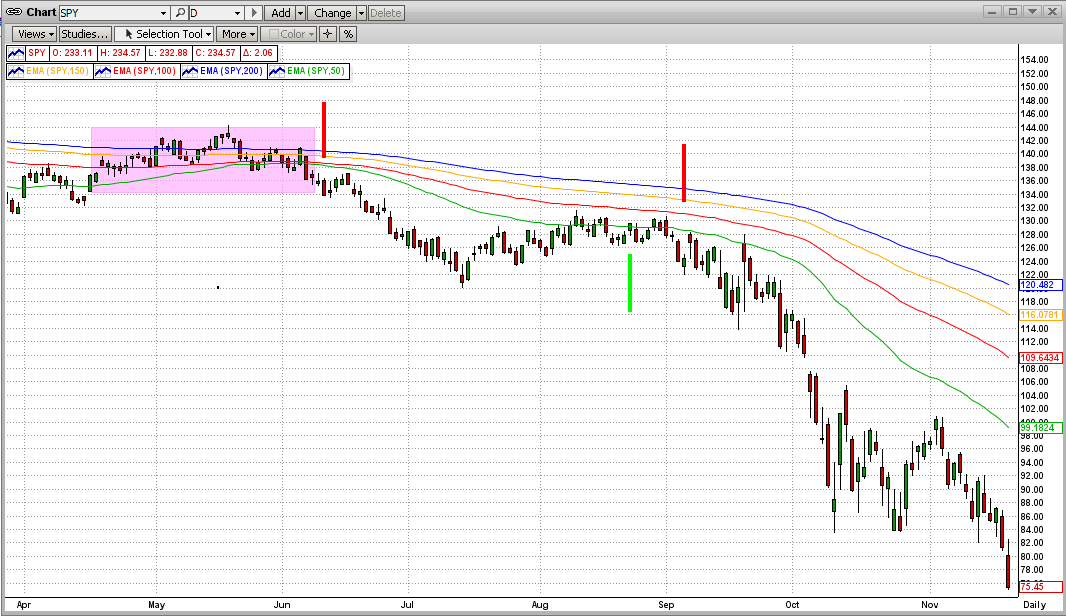
Also, please remember that the MIPS models are designed with higher-level math, pattern recognition, artificial intelligence and well over 100 standard market indicators. And, each of these have a certain "weight" in the final vote (long/short/cash). Through our "self-learning" algorithms, the "weight" of each of the above change over time, depending how accurate their "votes" were in the past. This works great for improving the performance of the MIPS models, but it makes it almost impossible for any "human" to predict the actual time or final cause of a MIPS signal change.
On average, the MIPS3 and MIPS4 models issue an average of 12-14 signals per year. The actual number of signal changes in any given year depends upon the number of times that the intermediate-term cycles change direction (as determined by the models). The MIPS models have traded 18-20 times in some years and only 3-4 times in other years. Some trends tend to go on forever (like now). Our current "Long" MIPS signal has been in effect for over 9 months now (a new record). Our main goal, of course, is making money, not just trading to be trading. Mission accomplished !!!
Please feel free to email or call us with questions...
Thanks,
Paul Distefano, PhD
MIPS Timing Systems, LLC
Houston, TX
281-251-MIPS(6477)
support@mipstiming.com
Sunday, March 19 2017
We sent out the email below at 1:24am today. Since then, we have been inundated by MIPS members asking us to show the "backtested" performance results from the newest MIPS3 and MIPS4 "Blaster" models that we referred to in the last sentence in the last paragraph in the previous email below.
I.) Original - That last sentence in the last paragraph read:
"Backtesting shows that the current MIPS3 and MIPS4 "Blaster Series" models would have produced results more than three times better than the results below from our original model. And, the maximum drawdowns would have been much smaller (14% vs. 20%)"
II.) Update - As you can see in the graph immediately below, the last sentence should have read:
"Backtesting shows that the current MIPS3 and MIPS4 "Blaster Series" models would have produced results of 4 times and 5 times better (20 and 28 times their money, respectively) than the results below from our original model. And, the maximum drawdowns would have been much smaller (10% vs 20%)"
MIPS3 and MIPS4 "Blaster" from 2007 - 03/17/2017 (Bacltested)
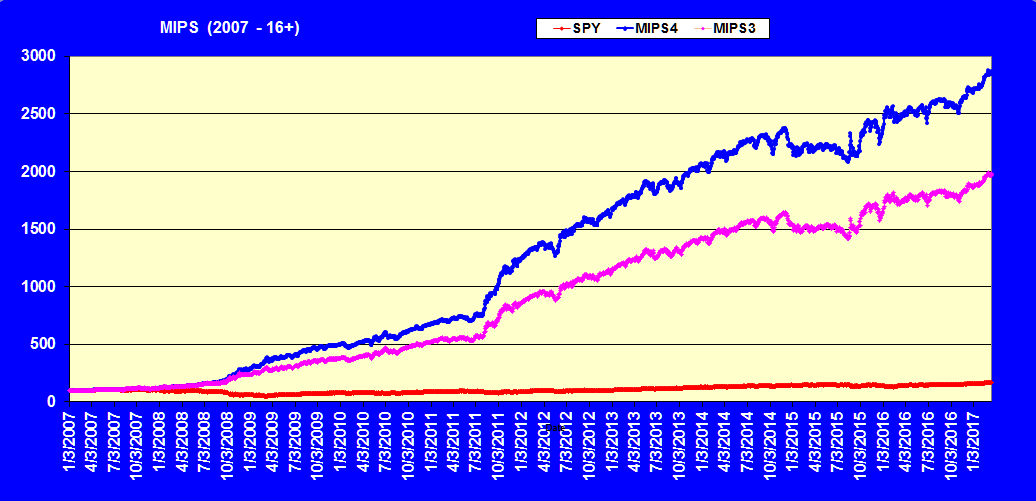
--------------------------------------------------------------------------------------------------------------------------------
Sent: Sun, 19 Mar 2017 01:24:24 -0500
MIPS Members:
As most of you know, MIPS is basically a Trend Following model, where a market "Trend" is defined as a market that either moves up over time with higher-highs and higher-lows (Up Trend), or moves down over time with lower-highs and lower-lows (Down Trend).
Technical analysts have discovered 27 cycles where identifiable trends occur. Many of these are for "Day Traders" who may trade 6-15 times a day to active traders who may trade 3-5 times a week. These would be identified as very-high-frequency traders.
We will concentrate herein on explaining the three most common (and broad) cycles that most individual analytical investors use; namely Short-Term Cycles (days-weeks), Intermediate-Term Cycles (weeks-months), and Long-Term Cycles (quarters-years). The MIPS models identify each of these trends, and trade mainly on the behavior of intermediate-term cycles (but will yield to short-term or long-term when the trend is extra strong and compelling).
Remember, the MIPS models trade between 6-15 times/year on average. But, no matter how often or how seldom a model trades, good models will almost never go against the trend (as in "Don't Fight the Trend"). So, some years the models could trade 18 times, and other years maybe only 2-4 times.
Also, please be aware that the MIPS models contain algorithms that will force themselves to abandon trend following analysis under certain conditions; such as flat-markets (trendless), compellingly over-bought or over-sold conditions (reversion to the mean), and VERY short-term cycles (to prevent getting whipsawed).
To bring this into our current conditions, please refer to the graph below. The time frame for this graph is between the market bottom in March 2009 and today. Therein, the short-term trend lines are the black ups-and-downs, the intermediate-term trend lines are green and red, and the very long-term term trend line (secular trend) is blue.
From the graph below, you can see with your own eyes that investors that stayed long the entire time from valley to peak (blue trend line) would have done well, as in 3.15 times their money from 75 to 237 in these eight years.
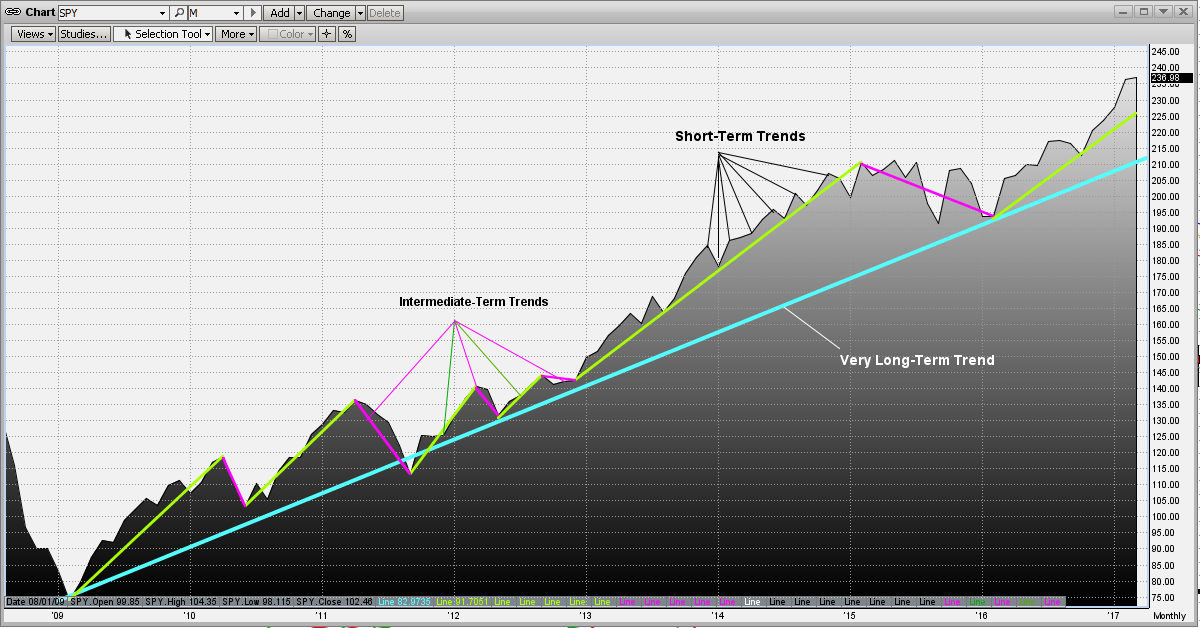
However, it is unlikely that many buy-and-hold investors would have been lucky enough to buy in at the very bottom in March 2008. Most buy-and-hold investors would have been in for a while, so how would they have done from the peak in October 2007 until now (March 2017)? For that, we will see the answer in the black trend line in the graph below. From this, it can be seen that investors would have 1.53 times their money from 155 to 237 (this is only about 1/2 of the growth from valley to peak above).
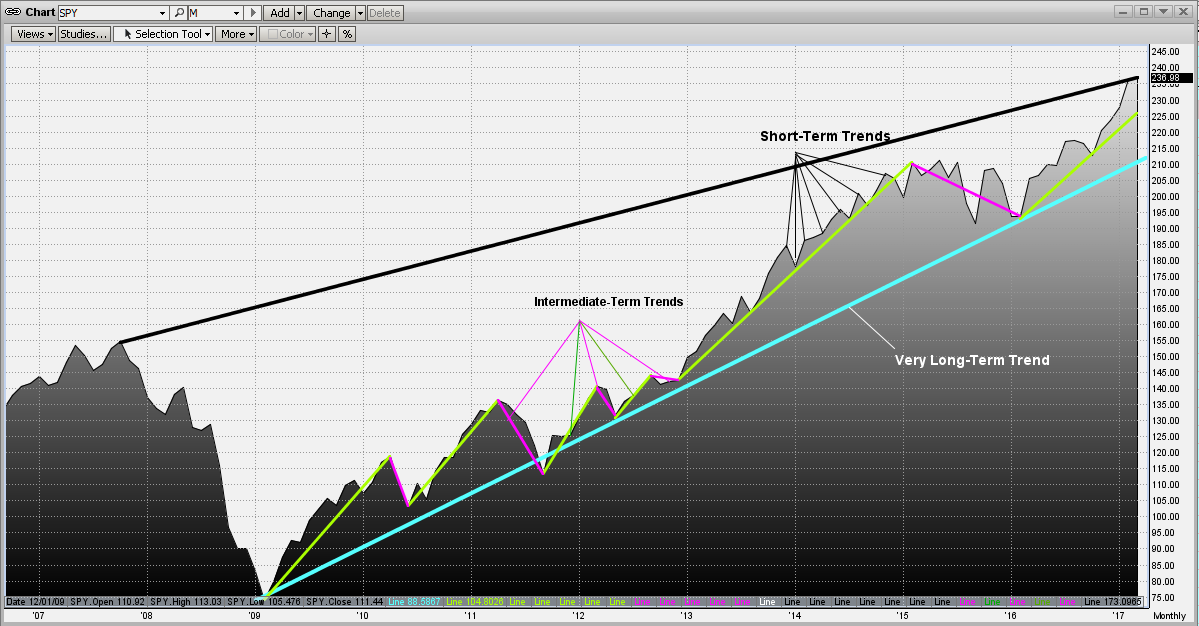
We will never know what would have happened with the short-term strategy, but we can say if the model was correct a large percent of the time, the returns would have been much higher that that above. But if the accuracy was only mediocre, investors would have gotten whipsawed and risked a large part of their portfolio.
The good news is we can show you verified results of how our "original" intermediate-term model (MIPS3) would have performed in the Oct 2007 to March 2009 time frame. For that, see the graph below from TimerTrac.com (the largest and most respected 3rd party model "tracking" company in the USA).
Investors that followed MIPS3 would have enjoyed gains of 5.20 times their money (much, much better than the 1.53 times their money from buy-and-hold). PS - Even better, these are the results from our original MIPS3 model, because it is the only one of our models that was live all the way back to 2007 (and hence has "verified" results). Backtesting shows that the current MIPS3 and MIPS4 "Blaster Series" models would have produced results more than three times better than the results below from our original model. And, the maximum drawdowns would have been much smaller (14% vs 20%)
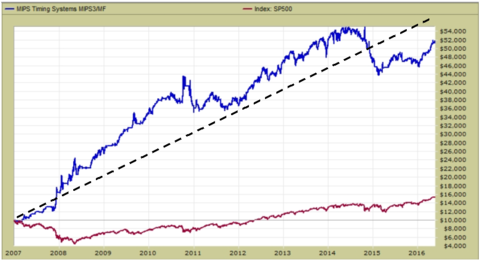
We are very proud of our MIPS models and their performances.
Paul Distefano, PhD
CEO / Founder
MIPS Timing Systems, LLC
Houston, TX
281-251-MIPS(6477)
Sunday, March 19 2017
As most of you know, MIPS is basically a Trend Following model, where a market "Trend" is defined as a market that either moves up over time with higher-highs and higher-lows (Up Trend), or moves down over time with lower-highs and lower-lows (Down Trend).
Technical analysts have discovered 27 cycles where identifiable trends occur. Many of these are for "Day Traders" who may trade 6-15 times a day to active traders who may trade 3-5 times a week. These would be identified as very-high-frequency traders.
We will concentrate herein on explaining the three most common (and broad) cycles that most individual analytical investors use; namely Short-Term Cycles (days-weeks), Intermediate-Term Cycles (weeks-months), and Long-Term Cycles (quarters-years). The MIPS models identify each of these trends, and trade mainly on the behavior of intermediate-term cycles (but will yield to short-term or long-term when the trend is extra strong and compelling).
Remember, the MIPS models trade between 6-15 times/year on average. But, no matter how often or how seldom a model trades, good models will almost never go against the trend (as in "Don't Fight the Trend"). So, some years the models could trade 18 times, and other years maybe only 2-4 times.
Also, please be aware that the MIPS models contain alogrithms that will force themselves to abandon trend following analysis under certain conditions; such as flat-markets (trendless), compellingly over-bought or over-sold conditions (reversion to the mean), and VERY short-term cycles (to prevent getting whipsawed).
To bring this into our current conditions, please refer to the graph below. The time frame for this graph is between the market bottom in March 2009 and today. Therein, the short-term trend lines are the black ups-and-downs, the intermediate-term trend lines are green and red, and the very long-term term trend line (secular trend) is blue.
From the graph below, you can see with your own eyes that investors that stayed long the entire time from valley to peak (blue trend line) would have done well, as in 3.15 times their money from 75 to 237 in these eight years.

However, it is unlikely that many buy-and-hold investors would have been lucky enough to buy in at the very bottom in March 2008. Most buy-and-hold investors would have been in for a while, so how would they have done from the peak in October 2007 until now (March 2017)? For that, we will see the answer in the black trend line in the graph below. From this, it can be seen that investors would have 1.53 times their money from 155 to 237 (this is only about 1/2 of the growth from valley to peak above).

We will never know what would have happened with the short-term strategy, but we can say if the model was correct a large percent of the time, the returns would have been much higher that that above. But if the accuracy was only mediocre, investors would have gotten whipsawed and risked a large part of their portfolio.
The good news is we can show you verified results of how our "original" intermediate-term model (MIPS3) would have performed in the Oct 2007 to March 2009 time frame. For that, see the graph below from TimerTrac.com (the largest and most respected 3rd party model "tracking" company in the USA).
Investors that followed MIPS3 would have enjoyed gains of 5.20 times their money (much, much better than the 1.53 times their money from buy-and-hold). PS - Even better, these are the results from our original MIPS3 model, because it is the only one of our models that was live all the way back to 2007 (and hence has "verified" results). Backtesting shows that the current MIPS3 and MIPS4 "Blaster Series" models would have produced results more than three times better than the results below from our original model. And, the maximum drawdowns would have been much smaller (14% vs 20%)

We are very proud of our MIPS models and their performances.
Paul Distefano, PhD
CEO / Founder
MIPS Timing Systems, LLC
Houston, TX
281-251-MIPS(6477)
Saturday, February 25 2017
A money manager (RIA) customer of mine uses our MIPS models along with models from other developers to trade his various strategies. He recently mentioned to me that he received an email from one of his other model developers that sounded almost apologetic for being in a Long Signal for so long (not to mention that his users have done very well in the last 12 months).
That sounds like MIPS. Our current "Long Signal" from 7/12/2016 now has the longest signal life in MIPS' 11-year history. As most of you know, I personally use a little leverage (but less than 1.5x), in order to "beat the market" some in extended uptrend periods (but almost never any leverage on short signals). That keeps me interested instead of getting bored.
BTW - With ETFs, you can effectively generate 1.5x leverage by buying 50% of the 2x SSO and 50% of the 1x SPY. Or, you can attain 1.25x leverage with 25% SSO and 75% SPY, and so forth. You trade 0.5x when you buy SPY with 50% of your investment money and leave the rest in cash (but ready to trade with on any day). With mutual funds, Rydex offers at least one 1.5x S&P 500 fund.
We will show you how MIPS3 would have behaved with these various trading profiles. The graphs below are MIPS3 trading SPY using verified signal data from TimerTrac.com. Let's look at the 10+ year period between 2007 and 2017 YTD in three views, namely:
I.) for the period 2007-2017 YTD (up and down markets),
II.) for the period 2007-2009 (mostly down market), and
III.) for the period 2009-2016 YTD (mostly up market).
The 3 lines on each graph below are with MIPS:
Green Line - Trading SPY with 1.5x Long and 1.0x Short - Aggressive
Gold Line - Trading SPY with 1.5x Long and 0.5x Short - Moderate
Blue Line - Trading SPY with 1.0x Long and 1.0x Short - Conservative
I. - For the period 2007-2017 ytd (up and down markets)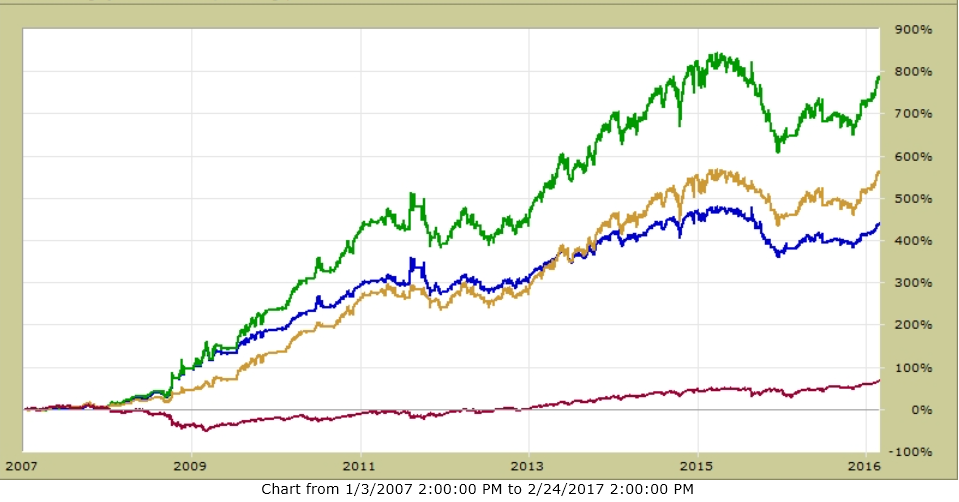
II - For the period 2007-2009 (mostly down market)
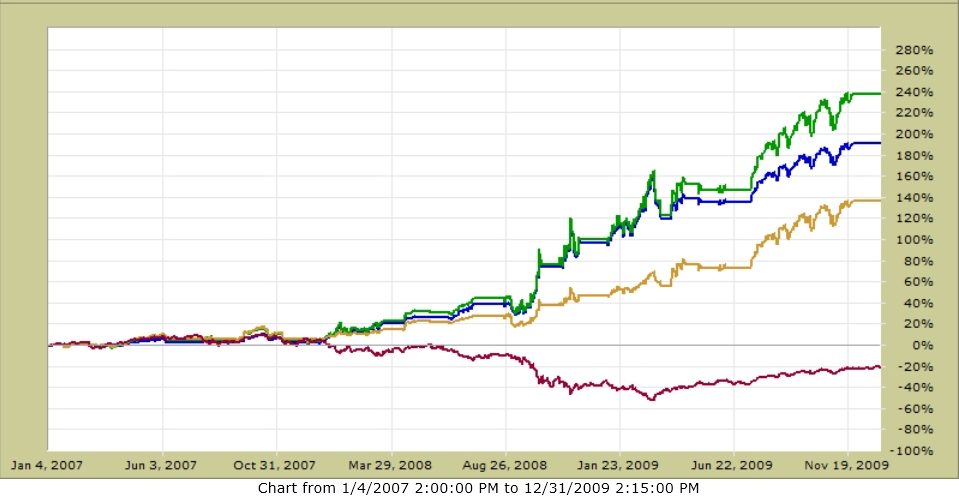
III - For the period 2009-2016 ytd (mostly up market)
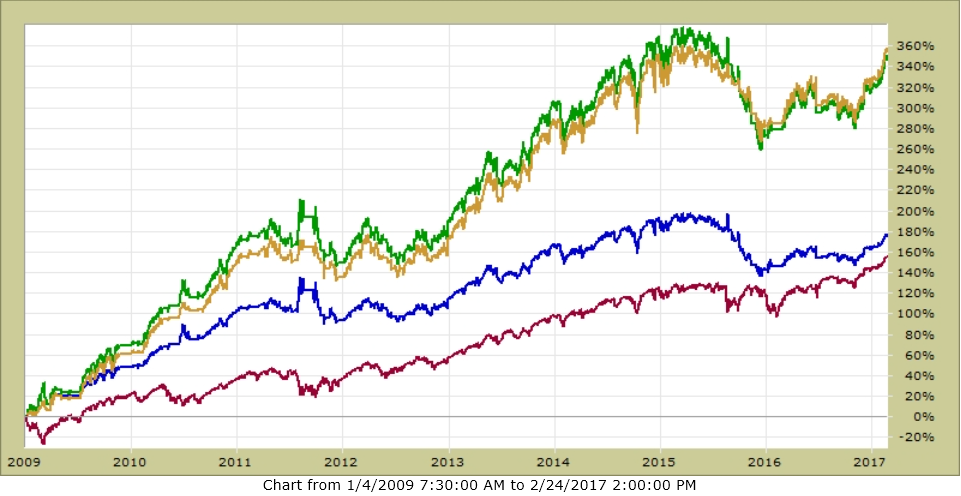
Note: The above is from our original MIPS3 model which has verified signals on TimerTrac.com going back to Nov 4, 2005. MIPS3 is still a very good model (ranked #1 on TimerTrac.com since 2006). MIPS4 is a better model, but it only has verified signals since Sept 2013.
No one can tell you which of these is best for you, it depends upon your risk/reward temperament; that is, can you take higher risk (bigger drawdowns) for higher rewards; or would rather minimize your risk and be willing to give up some performance.
Most good investors get a little more aggressive in up markets (to a point of the market being way too "overbought") and cut back on risk in shakier markets (like sideways waffling). Remember, you do not have to marry any of the above strategies, but do not switch them every time the market makes a little move up or down ("wiggles").
Let's enjoy this ride while it lasts. Some time this year I will most likely be explaining to you why MIPS is trading so often. That's all part of the success.
Stay tuned...
Paul Distefano, PhD
President/CEO
MIPS Timing Systems, LLC
Houston
281-251-MIPS(6477)
Tuesday, January 31 2017
The market pundits are citing things like the Trump rally has run its course and that February is NOT normally a good month in the stock market. As "proof" they point out that, in the last 40 years, in the "good months" between November-April (where they all go when they come back from "sell in May"), February has average gains of only 0.06% (yes, that's six 100ths of a percent). Furthermore, in the February's following presidential election years, the market has dropped an average of -1.85%.
So, what are the last few days in the market telling us from a technical standpoint.
See the graph below:
1) the bold black trend line on the left is the "Long-Term Trend",
2) the light gray trend line extension is what I have called the Post Election Trend Line, but it really
is just a natural continuation of the long-term trend line.
3) the orange circle on the top right is a "fake break" to the upside,
4) the blue lines point out where the SPY has dipped to its trend line, hit it, and bounced back up
(in technical terms, the support level "held its ground" each time, which is bullish).
5) For our hard-core technical MIPS members, let us not ignore another bullish technical indicator.
Today (Tuesday) the SP500 "candlestick bar" formed a near-perfect "up hammer", by opening down
(-7 on SP500), falling another -7 point segment during the day (-14 total), and then bouncing back
up to close +12 points above its low-point (-2 for the day). PS - The graph below is for the SPY,
not the SP500; but of course, the similarity is there.
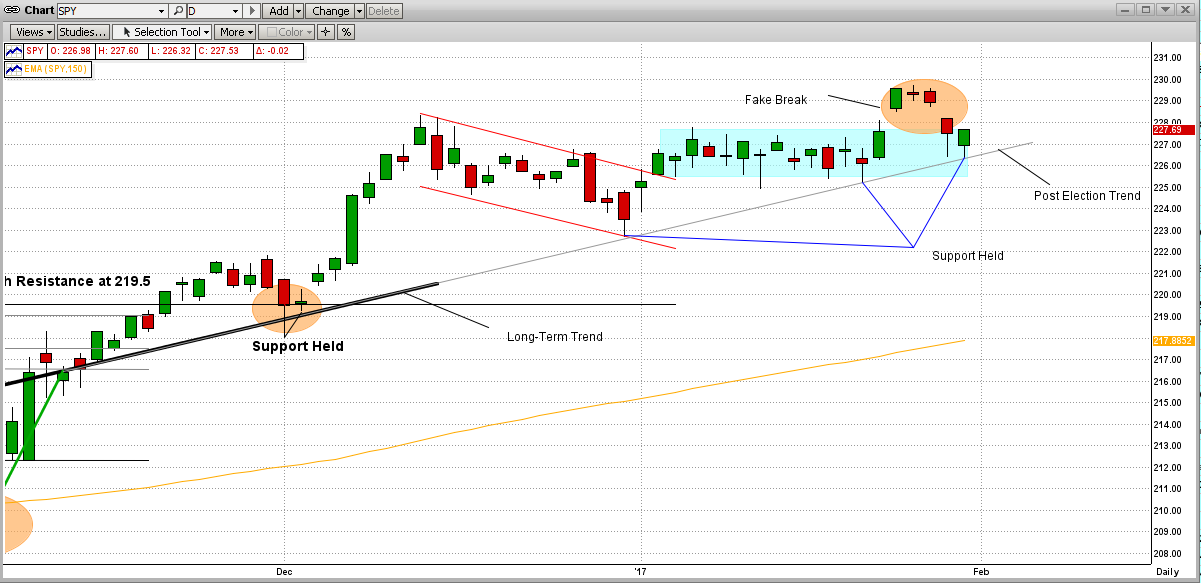
Of course, today's action is not why MIPS has stayed in a long position for so long (read previous blog for why that is). It is mainly because a good trend following model will rarely go short when the market is above its trend. But, good trend following models (like MIPS) will have algorithms that will take themselves short or to cash with a relatively big drop above the trend line [e.g., reversion-to-the-mean algorithms in overbought (or oversold) markets].
Overall, by following the trend, the MIPS models have done well in the recent market (see graph below).
- from TimerTrac.com
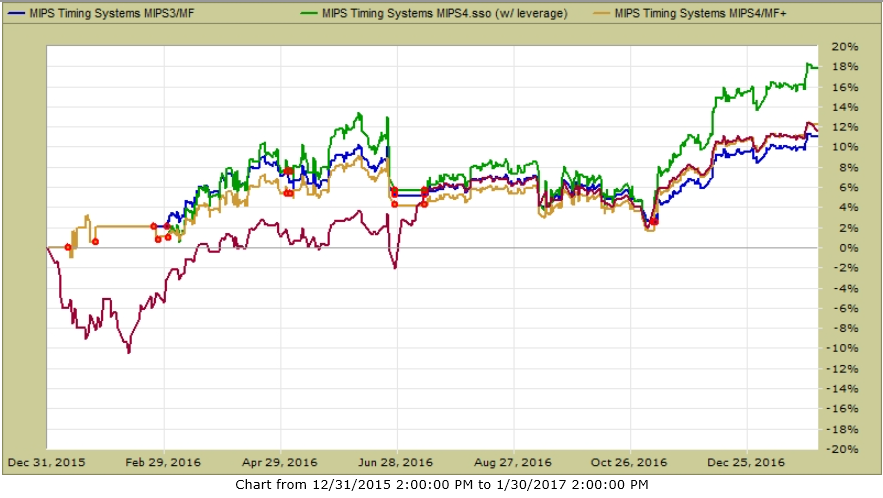
In the above, you can see the following results for the time period of Jan'16-Jan'17:
Red Line - S&P 500 = +11.9%
Blue Line - MIPS3 trading SPY 1.0x Long and 1.0x short = +11.1%
Gold Line - MIPS4 trading SPY 1.0x Long and 1.0x short = +12.2%
Green Line - MIPS4 trading SPY 15.x long and 1.0x short = +17.9% *
* note: 1.5 leverage on long positions
Stay tuned...
It appears that the market will continue to the upside, but let's wait for MIPS to provide us with more "good guidance" going forward !!!
Paul Distefano, PhD
President/CEO
MIPS Timing Systems, LLC
Houston
251-281-MIPS(6477)
Sunday, January 29 2017
Trading frequency is a very important part of the performance of timing models. If you look on TimerTrac.com, you will find long/short timing models that trade between 10-80 times/year. If you use a long/short model, these "trades" are basically "round trip trades", which require two actual trades on every "signal change". For example, a new long signal would require that you: (1) cover your existing short position, and then (2) buy your new long position. At $10/trade, a model that trades 50 times a year (50 round trips) requires 100 actual trades (lots of work) and costs $1,000/year in trading fees. Whereas, a model that trades 12 times/year requires 24 trades/year and would cost $240/year at $10/trade.
As most of you know, the MIPS2 model trades about 8 times/year and the MIPS3 and MIPS4 models trade between 12-14 times/year. Since MIPS3 and MIPS4 are better models, we recommend that you use them even though they trade a little more often. Please remember that the trades/year are "averages" and could mean that in some years the MIPS3/4 models could trade 4-6 times/year and in other years they may trade 16-18 times/year.
What determines how many times/year a model trades is 90-100% dependent upon how long the market trends in that year last (other trades may come about from reversion-to-the-mean in overbought/oversold markets, etc.). The MIPS models were developed to follow "Intermediate-Term" trends (weeks/months); and not "Short-Term" trends (days) nor "Long-Term" trends (months/years).
In the last 5-6 years, the market has trended up somewhat consistently. However, in the graph below, you will see that the market in 4Q'15 trended down. But, before and after 4Q'15, the SPY trended up in a relatively tight pattern. So, after 4Q'15, models that were "long" more often than "short" should have matched or beat SPY (especially with like 1.5x leverage on long signals).
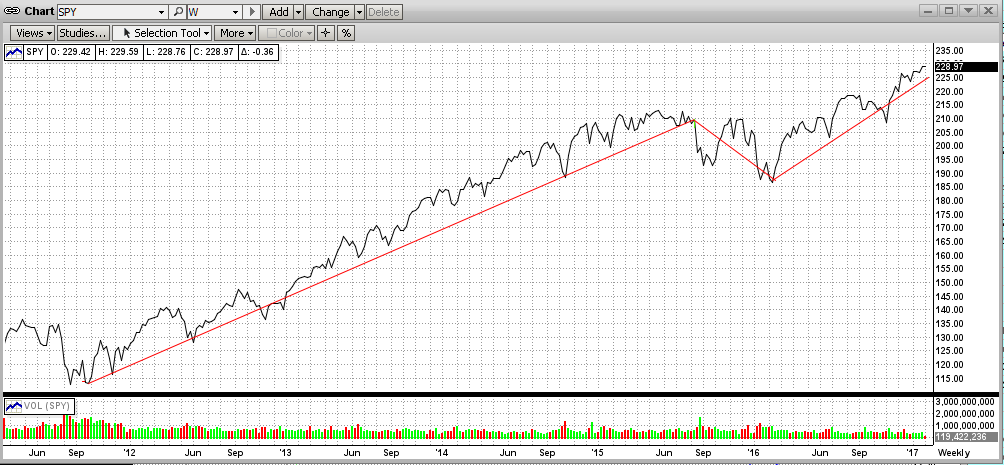
Getting closer to home, we all know that MIPS4 has been Long since 07/12/2016 (135 days)!
- [MIPS3 did basically the same, but with a one-day cash position on 11/04/2016].
Incidentally, in the 14 years since 2003, MIPS3 has had 11 signals that lasted longer than 3 months (90 days), with the longest signal lasting one year (361 days). All 11 of these signals were winning signals (even a short signal in 2008). The average gain from these 11 signals was 9.90% each. [This would have been higher with 1.5x leverage, see the last graph.]
See the graph below to follow the trend of the SPY since 07/12/2016. As you can see, the SPY trend was up most of the time, except for a dip in early November. BTW, in a strong up market like this, it takes a bigger dip than that for MIPS to change direction. And, chasing ralatively small dips can lead to getting whipsawed. Remember, our Blaster Series algos in 1Q'16 greatly lessen the chance of the MIPS models from getting whipsawed !!!
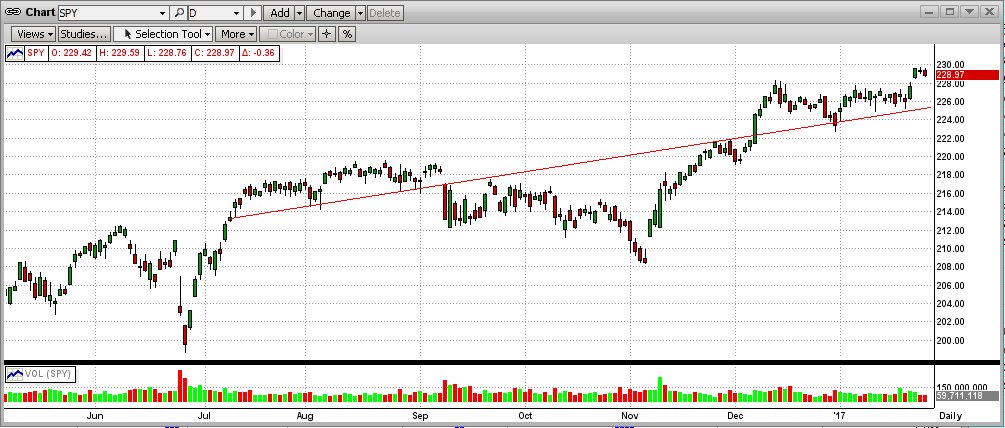
So, how did this 135-day long signal since 07/12/2016 perform. The graph below shows MIPS4 with a 7.9% gain and MIPS3 with a 5.8% gain, both trading SPY with no leverage.
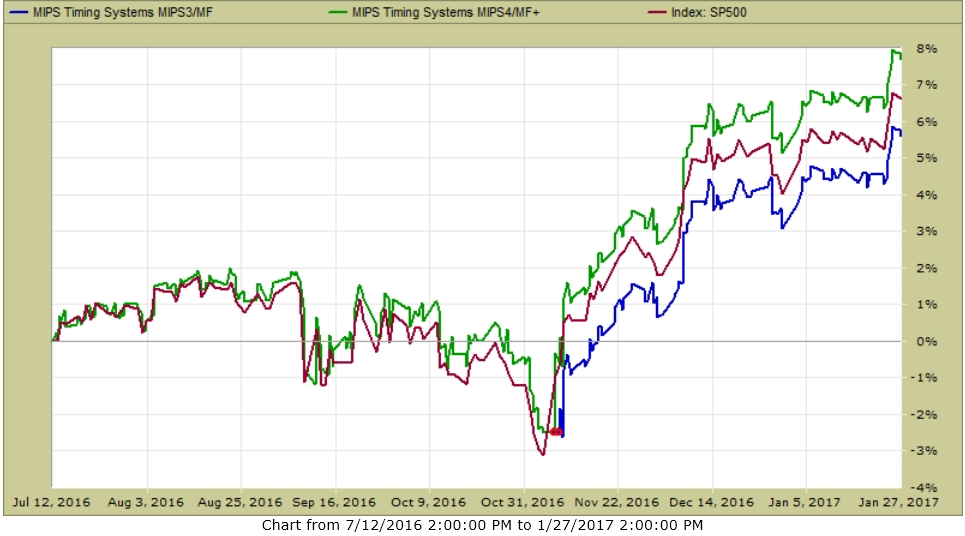
With 1.5x Leverage
The graph below from TimerTrac.com shows how MIPS3/4 would have performed trading SPY with 1.5x leverage on long signals and 1.0x leverage on short signals (MIPS4 +11.8%; MIPS3 +8.6%).
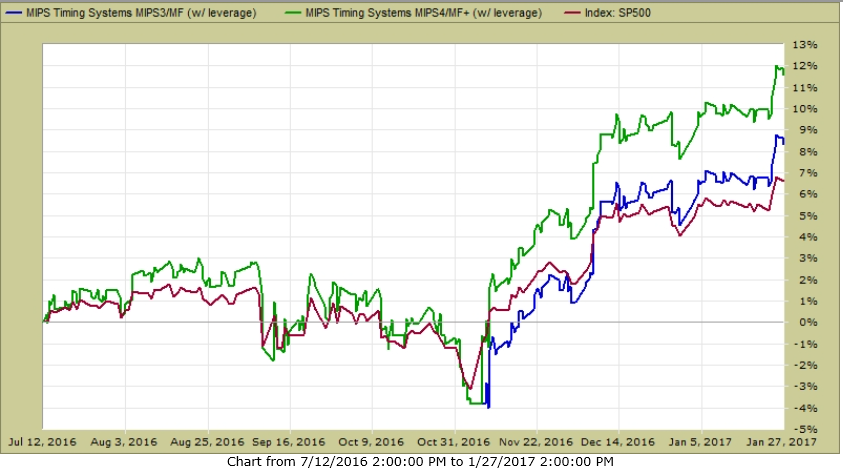
Paul Distefano, PhD
MIPS Timing Systems, LLC
Houston, TX
281-251-MIPS(6477)
www.mipstiming.com
Monday, December 26 2016
Santa Claus Rally, December Rally, Trump Rally... what difference does it make... a rally is a rally !!!
Traditionally the Santa Claus Rally in December is believed to result from:
(1) Mutual funds, etc., "dressing up" their portfolio by selling all of their losers and buying winning
stocks that have done well during the year. This way, all stocks in their year-end portfolios look
really good (show gains), even though the fund did not actually participate in these gains. Some
fund's year-end portfolio may show 90% of the stocks up 10-30% in 2016, when in actuality
the fund was actually up only 2-3% for the year. Sounds like "cheating" doesn't it? At its best,
this very misleading.
(2) In the last half of December, the pros have done their dirty deeds and have left on vacation
for the rest of the year. Usually, the market sentiment is high from the runup in the first half
of December. And then, in the last half, the "little guys" come in and push the market even
higher on relatively low volume.
(3) In 2016, all of the above have been aided by the Trump rally.
So, according to the above, December should finish with a nice gain (see graph below).
BTW:
- all MIPS models went long on 7/11/2016.
- MIPS4 was still long on 11/07/2016 (as was MIPS3, after it got called back to cash for a few days).
We MIPS members will wait for MIPS to tell use what to do next...
Stay tuned...
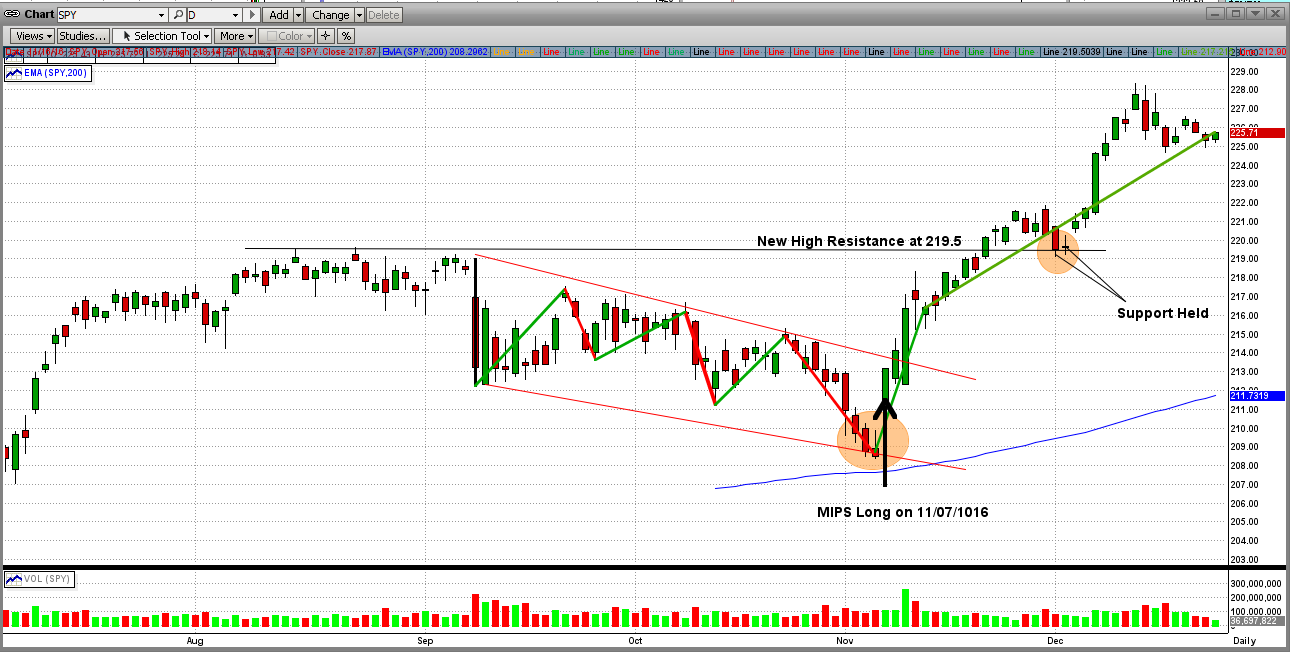
Paul Distefano, PhD
CEO / Founder
MIPS Timing Systems, Inc.
Houston, TX
281-251-MIPS(6477)
Sunday, December 11 2016
From the MIPS website at:
http://www.mipstiming.com/rias___nitro1
MIPS/Nitro up 14.3% thru 12/09/2016 (1.5x leverage long, 1.0x SH short)
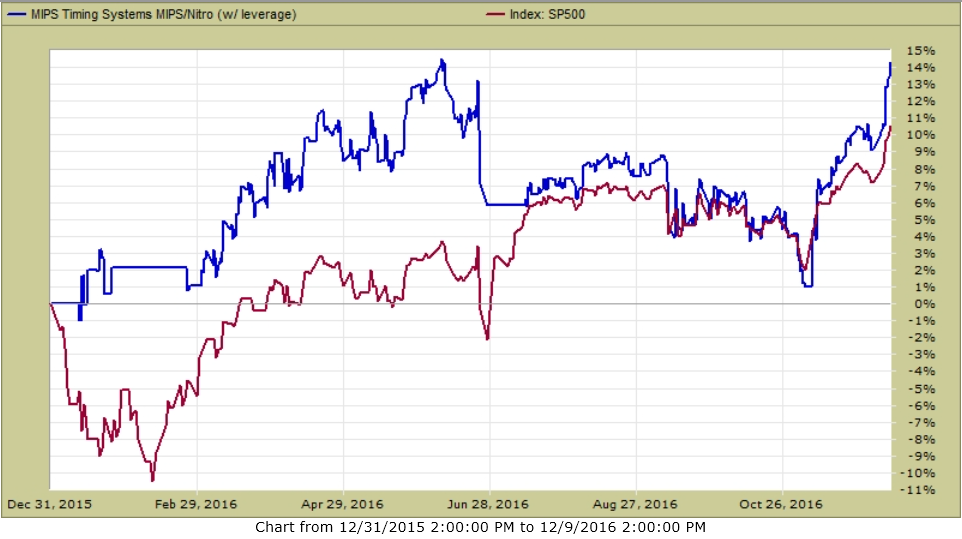
Paul Distefano
--
--- Contact Info ---
Paul Distefano, PhD
CEO/Founder
MIPS Timing Systems, LLC
Houston, TX
281-251-MIPS(6477)
www.mipstiming.com
pdistefano@mipstiming.com
Sunday, December 11 2016
From the MIPS website at:
http://www.mipstiming.com/home
MIPS3 up 8% thru 12/09/2016 (no leverage)
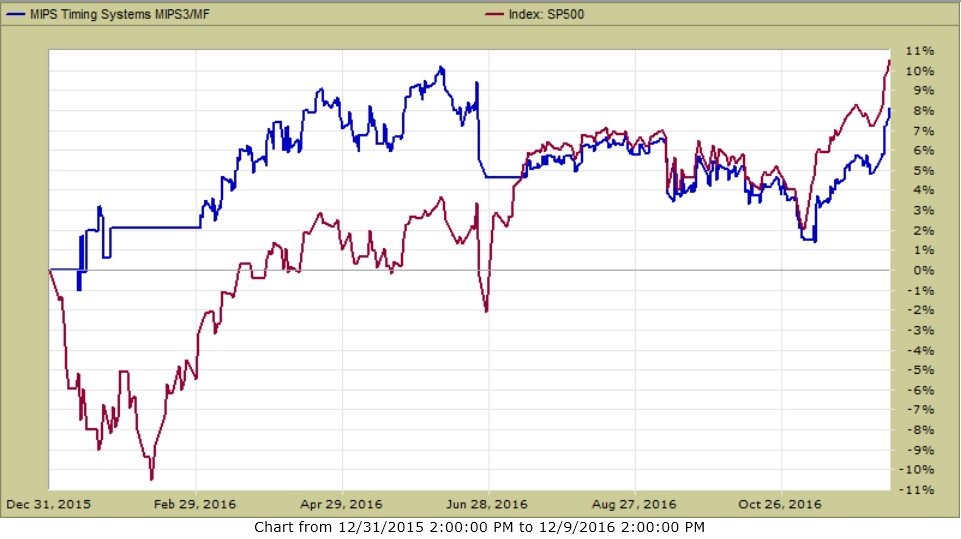
Paul Distefano
--
--- Contact Info ---
Paul Distefano, PhD
CEO/Founder
MIPS Timing Systems, LLC
Houston, TX
281-251-MIPS(6477)
www.mipstiming.com
pdistefano@mipstiming.com
Monday, December 05 2016
Good News - The recent new highs are beginning to look like traditional new highs. The S&P 500 broke out above its long-time resistance at 2165 (216.5 on the SPY) on 11/20/2015. This was a BIG event !!!
Since then, the SPY has done what markets making new highs do. That is: (1) break to the upside, (2) come back to test its support level (the old resistance level), and (3) bounce back above the support level with force. And bounce back it did.
Seven days after the SPY "broke out", for next two days it bounced off of its support level, its long-term trend line, and its 12-day EMA; and then it gapped up today (orange ellipse on the top right in the graph below) . From here, the sky should be the limit; but what "should be" does not always happen.
Stay aware, and watch for the MIPS signals to tell us what to do from here...
Stay tuned...
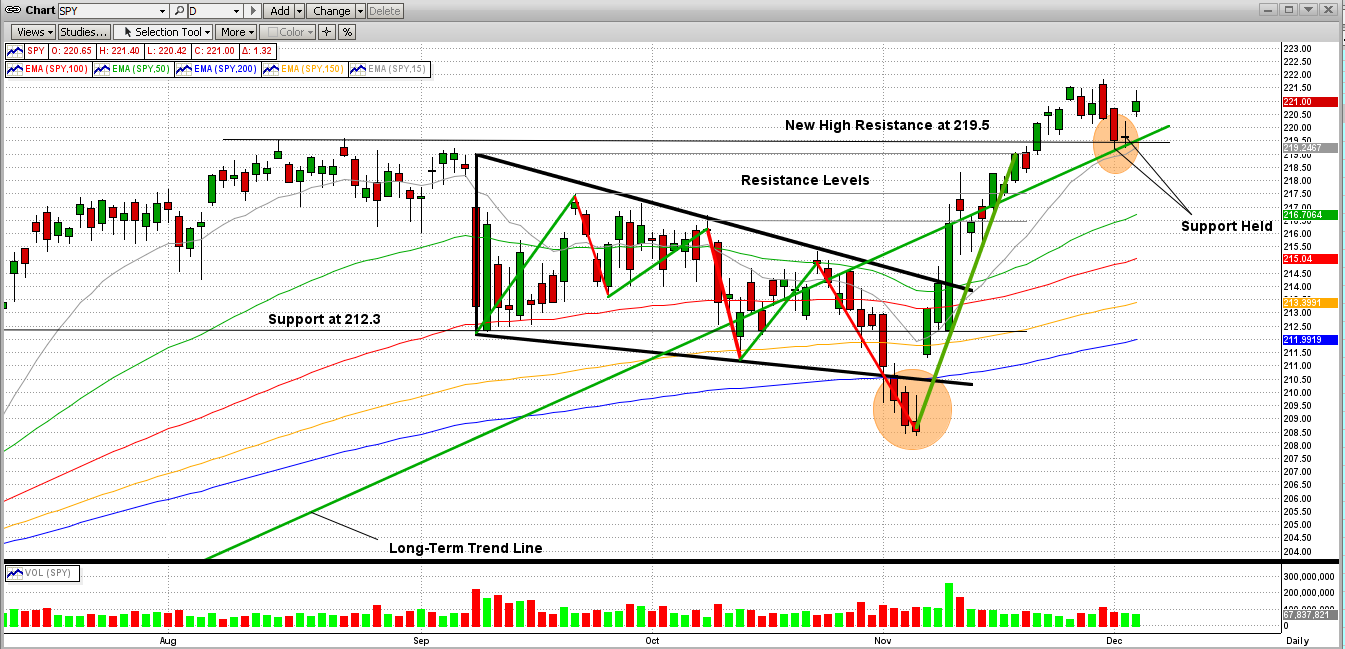
Thanks,
Paul Distefano
<<< Contact Info >>>
Paul Distefano, PhD
CEO / Founder
MIPS Timing Systems, LLC
Houston, TX
281-251-MIPS(6477)
================================================================
<<< Previous Blog >>>
MIPS - New Highs Coming ???
MIPS Members:
After going sideways for almost two years now, the market could be about to break out to the upside. This is somewhat obvious when we look at the long-term trend in the markets. Keep in mind that the Dow, the NASDAQ, and the Russ2K have already hit new highs. Is the mighty SPY next? Instead of looking at daily graphs now, let's first look at a monthly graph of the SPY (ETF for the S&P500).
In the graph below, you will see that our long uptrend is still in effect, but the SPY has waffled for 2 years (24 monthly bars up-and-down in a tight range), with a rather weak breakout 4 months ago. Usually when this happens, the SPY is "topping" and a crash is imminent; but not always. For example, if the market gets a catalyst that results in a strong rally at a time like this, the bull market can run higher, at least for a few months. Of course, if whatever caused the catalyst is the "real thing", we could see a strong market for a long time. Read on...
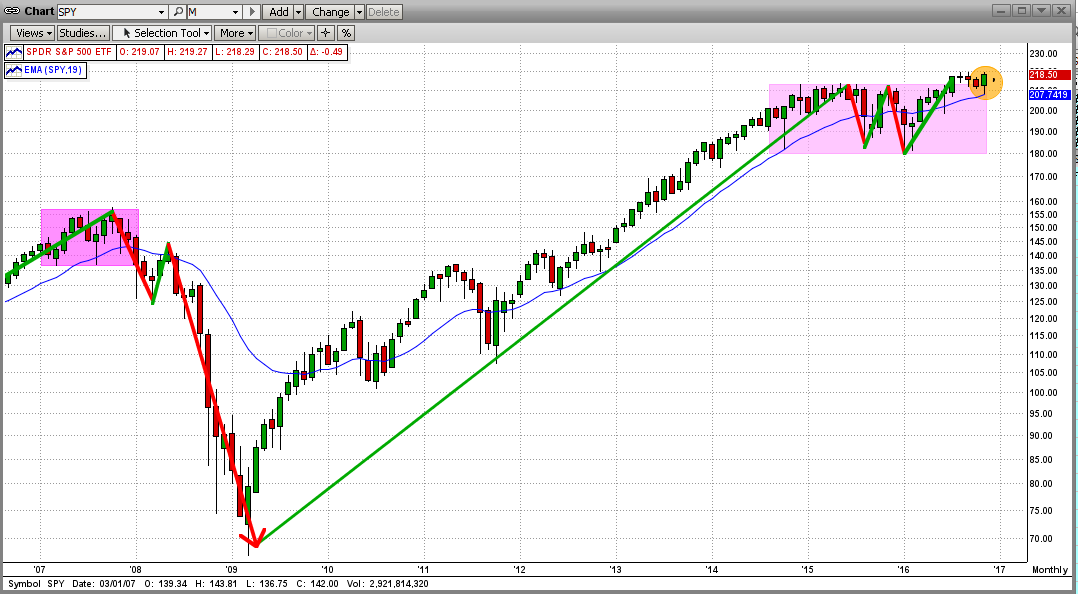
Of course, the "catalyst" this time was the surprising Trump victory in the presidential election ("Trexit"). Because of Trump's bold plans for infrastructure spending, bringing "blue collar" jobs back to the good old USA, etc., the Trump win led big investors to rotate their holdings into industrials (like Caterpillar) and financials (like Goldman Sachs) at the expense of the laggards (like utilities). And, this happened very quickly. So far, the buying has continued.
Even with (and maybe because of) the bullish sentiment of, and rally in, the markets in the last few weeks, the market could experience a setback soon. See the next graph below.
The all-time high for the S&P 500 is 2195 (approx 219.5 on the SPY). As you can see, the SPY reached a resistance strong point of 219.0 on Thursday, and got beaten back by the bears lurking there. That was not good, but not overly bearish (yet). Almost surely, the SPY will make another set of "charges" at the strong resistance levels at 219.0-219.5 in the next few days/weeks, and the winner will then be known (bulls or bears).
Keep your eyes fixed on these price levels in the next few days/weeks, while letting MIPS tell you how and when to trade, if at all ... MIPS members can see the current signals for all MIPS models here: http://www.mipstiming.com/current_signals
History has shown that breaking (and staying) in new-high territory is very difficult. On the other hand, if the bulls prevail with a strong break (say on high volume), the sky will be the limit for a while (nice sailing).
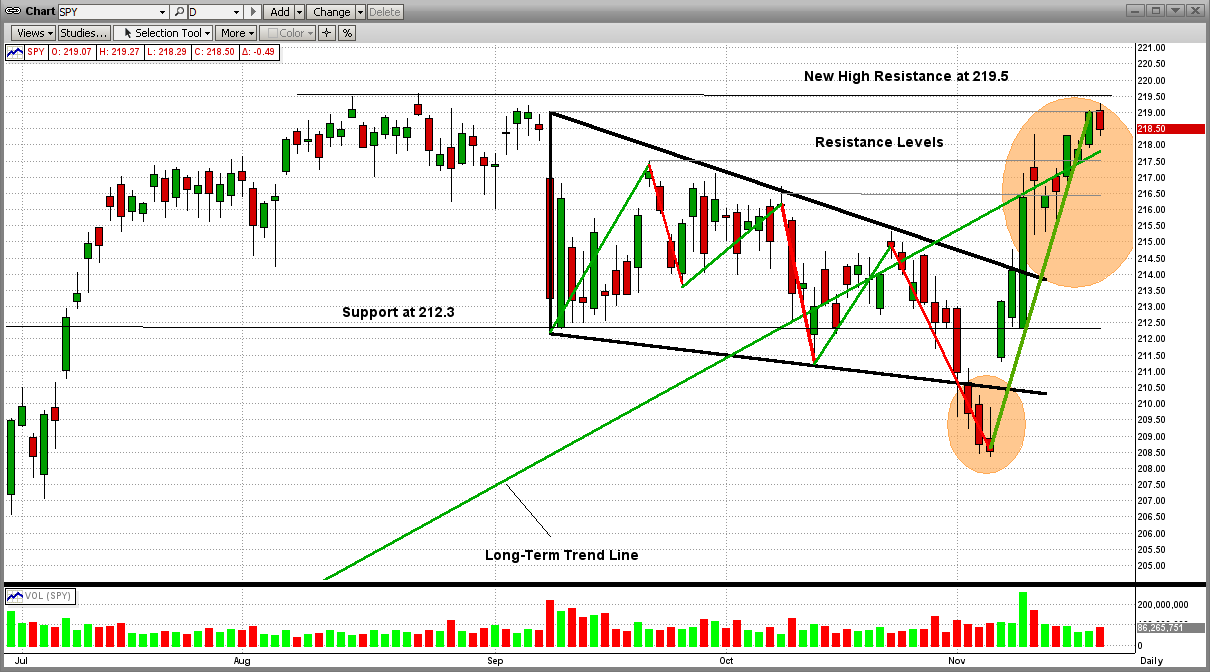
Thanks,
Paul Distefano
<<< Contact Info >>>
Paul Distefano, PhD
CEO / Founder
MIPS Timing Systems, LLC
Houston, TX
281-251-MIPS(6477)
|